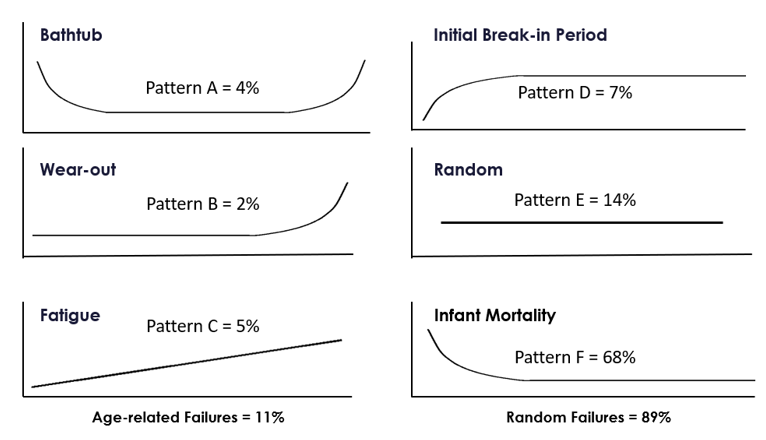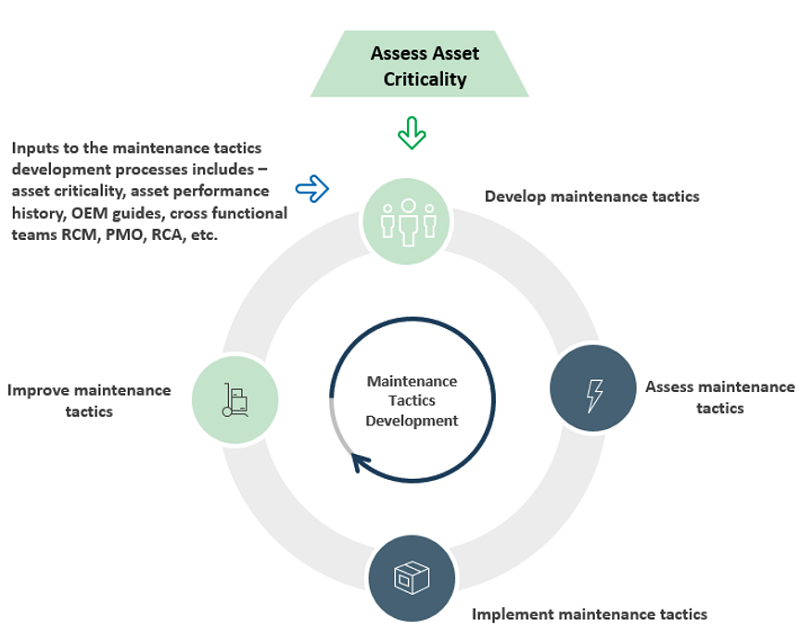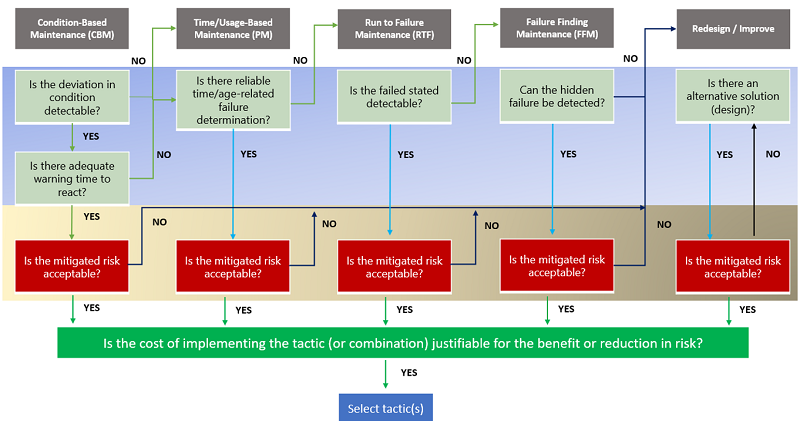INTRODUCTION
The challenges of the global economic climate and intense competition in the market requires organisations to pursue a level of performance and cost efficiencies that's better than their competitors to remain viable. Maximising the realisation of value from physical assets through asset management requires an integrated approach to support the achievement of organisational objectives. Subsequently, the evolution of maintenance practices over the years has placed maintenance as a strategic function that can help deliver business outcomes. However, the development of appropriate asset failure prevention tactics remains a key challenge, as the complexity of equipment and asset systems involved constantly evolves.
This article, part of our series on Equipment Reliability, we look at maintenance tactics and their role in assisting organisations extract maximum value from physical assets through optimising and preserving equipment uptime and inherent reliability. As we have previously discussed the objectives of maintenance is to ensure that physical assets continue to fulfil their intended functions to the standards of performance desired by the user. As a result, any assessment of how well maintenance is achieving its objectives must entail an assessment of how well the assets are continuing to fulfil their functions to the desired standard, which are influenced by three factors:
- ‘continuity’ can be measured in several different ways, i.e.,
- how often it fails?
- how long it lasts?
- how long is it out of service when it does fail?
- how likely is it to fail?
- users have different expectations of different functions, i.e.,
- every function has associated with it a unique set of continuity (reliability and/or durability and/or availability and/or dependability) expectations.
- the issue is complicated by the fact that the loss of function can be caused by more than one – sometimes several – of failure modes.
- each failure mode has associated with it a specific failure rate (MTBF), and
- each will take the function out of service for an amount of time which is specific to that failure mode.
- individual assets can have more than one and often several functions, i.e.,
- the most important point about measuring the effectiveness of maintenance activities is the fact that every asset has more than one and sometimes multiple functions.
- this means that if an asset has 5 functions, then the effectiveness with which the asset is being maintained can be measured in, at least, 5 different ways.
When evaluating the contribution which maintenance is making to the performance of any asset, the effectiveness with which each function is being fulfilled must be measured on an on-going basis. This in turn requires a crystal-clear understanding of all the functions of the asset, together with a clear understanding of what is meant when it is said to be ‘failed’.
The decision to use RCM stems from a rigorous set of questions such as:
The case for development of effective tactics
Effective asset management requires organisations to optimise the trade-off between productivity, cost, and risk, without compromising on safety. Organisations that are best at making this trade-off are those who take a reliability-centred maintenance (RCM) approach to understand their physical asset’s functions, how they can and what cause them to fail, and how failure consequences can be prevented or mitigated.
Leaders in organisations operating in the reactive regime hold the un-enlightened view of maintenance as a repair function, a necessary evil, an unnecessary cost, a rapid response function to put our fires, etc. A great deal of education is needed to help leaders understand the objectives and value of maintenance in ensuring physical assets continue to fulfil their intended functions at the standard of specified performance levels. Several studies have shown that in best performing plants, reactive maintenance is less than 10% as compared to reactive plants where its high as 50% or more. What the best performers do well is to deploy predictive or condition-based maintenance practices to base actions on equipment condition using assessment tools such as e.g., vibration analysis, lubricant analysis, ultrasonic analysis, thermography analysis, risk-based inspections, etc. Moreso, reactive maintenance tends to cost 30% more than preventive maintenance and 100% more than predictive maintenance practices, Hudachek & Dodd (1977).
Equipment Failure Patterns
Before we explore maintenance tactics to assure plant reliability, we must look at equipment failure patterns which profile the conditional probability of failure as a function of time (age) for plant equipment.

Figure 1: Probability of failure curves over time
Referring to Figure 1, typically only 2% of equipment failures follow a wear-out pattern in which routine preventive maintenance (PM) i.e., periodic overhauls, repairs, or parts replacements, etc. makes sense. The wear-out pattern assumes that equipment will experience a few random, constant failures, after some time its probability of failure will sharply increase. Therefore, PM should be done prior to reaching the wear-out zone. The most important thing from these graphs is that only about 11% of equipment failures are purely age-related and have failure patterns matching the bathtub, wear-out and fatigue curves. Figure 1 also shows that most equipment failures, over time, are random at 89%. This has profound implications on equipment maintenance strategies.
With a high and random conditional probability of failure over time, its best to have condition monitoring in place to identify / defect early onset of equipment failure (i.e., point ‘P’ on the well-known P-F curve) well in advance before reaching its ultimate failure (i.e., point ‘F’ on the P-F curve). This will also allow for timely planning and scheduling of corrective maintenance work needed to preserve the asset function(s).
The 68% of infant mortalities shown in Figure 1 happen during equipment design (incorrect material selection, low reliability component selection, etc.), manufacturing (defects during the process, non-conformance to design specs, etc.), installation (human errors, misaligned drive trains, components placed on uneven surfaces, etc.) and start-up. In all these stages defects are introduced into the equipment and the overall inherent reliability and availability of the equipment is gradually affected. Therefore, developing effective maintenance tactics that specifically address infant mortality and random failure rates will ensure maximum value extraction for the business since they represent nearly 90% of all failures. Best performing organisations are dedicating their time and efforts in developing and deploying maintenance strategies that eliminate these failures through a combination of strategies.
Reactive plants often do not understand or underestimate the effects of the various failure curves and apply a blanket approach of treating every failure as though its age-related. They too can benefit with understanding the probability of failure curves over time for their equipment.
Maintenance Tactics Development
Asset maintenance tactics development and management, thereof, is a dynamic process to identify, assess, implement, and improve maintenance tactics for assets based on operating context and criticality to the business. They are implemented to address various failure modes identified through methodologies such as,
- reliability centred maintenance (RCM)
- failure modes and effects analysis (FMEA)
- reverse RCM (also known as planned maintenance optimisation – PMO)
The main objective to the business in applying asset maintenance tactics development is that asset owners, maintenance managers, plant reliability engineers, plant managers, etc. can supply safe, reliable, productive, and cost-effective assets to deliver maximum value to the business and its stakeholders. As previously mentioned, the main objective of maintenance is to deploy effective actions targeted at preserving the inherent reliability and availability of physical assets in a manner that ensures business objectives are met. By understanding the nature, causes, and consequences of failures, business can deploy strategies to ensure that physical assets perform their intended functions whilst committing only the resources necessary to preserve the integrity and health of assets.
Effective asset maintenance tactics development must include the main processes shown in Figure 2.

Figure 2: Main processes for asset maintenance tactics development
Figure 2 shows the various processes to be included in the asset maintenance tactics development process:
- conduct asset criticality analysis
- develop asset tactics
- assess asset tactics
- implement asset tactics
- improve asset tactics.
An overview and description of the activities taking place in the steps will be provided in the following section.
Asset Criticality Analysis - as operations can contain hundreds and thousands of pieces of equipment, making it unrealistic that equal effort and focus will be devoted to all assets on site. The objective of this step is:
- to devote effort and resources to those assets which present the greatest risk of failure.
- assess the level of thoroughness to be applied in the tactics development process.
Not all failures are of equal importance or matter, hence this step plays a major role in key elements such as Defect Elimination, Spares/Inventory Management and Work Prioritisation.
Defining and Selecting Asset Tactics - appropriate methodology for developing the tactics is a decision to be made by or dictated by the site’s asset management policy. We already mentioned the various methodologies that can be applied i.e., RCM., FMEA, reverse RCM (also known as PMO). An overview of the selection logic is shown in Figure 3.

Figure 3: Tactics selection guide / logic
Determining task intervals for an on-condition task, the P-F interval is used. The task interval should not be determined by how often it fails. For scheduled discard, restoration or replacement tasks, the task interval depends on the failure characteristics.
The task interval for Failure Finding can be calculated using tolerable unavailability and the Mean Time Between Failures (MTBF), such that:
Failure Finding Interval = 2 x Unavailability (%) x MTBF Assessing Asset Tactics – is the process of determining whether the task is worth doing i.e., does it reduce the risk associated with the failure mode to a tolerable level? The developed tactics should be assessed against various elements, such as:- Safety
- Production volumes
- Operating & replacement costs
- Environmental effects
- Company reputation
- Product quality
This is undertaken by a multi-disciplinary team. A worthwhile tactic is one which lowers the consequences of failure for the business to an acceptable / tolerable level.
Implement Asset Tactics - is a three-step process of:
- developing and validating the work procedures
- packaging asset tactics
- deploying tactics into a CMMS / EAMS
Tactics must be packaged at practical intervals by both trade and discipline. This minimises disruption to the plant and optimises the logistics of mobilising personnel, equipment, and materials.
Effective planning and scheduling of tactics ensures that tasks are completed effectively, on time, by appropriate resources, and at the appropriate interval.
Improve Asset Tactics - the activities involved in this process include selecting the asset(s) that require improvements, collecting and validating data, selecting, and applying the improvement methodology. This will be triggered by the observed asset performance, over a period, if it does not attain its KPIs. The improvement can be triggered as well by outputs from the Defect Elimination program. This topic is very in-depth and not possible to cover every element in deep details, but we hope it shared light onto the asset maintenance tactics process and the various processes involved.
